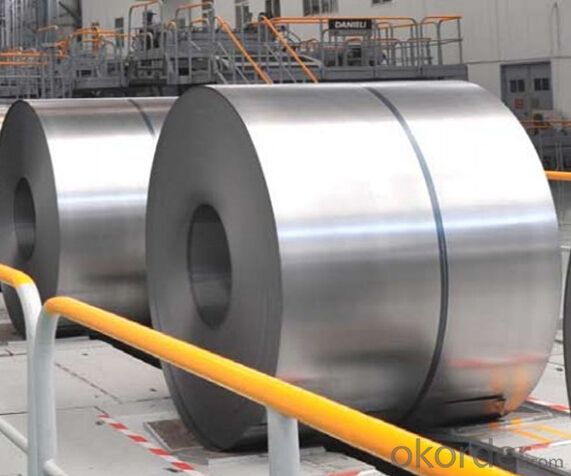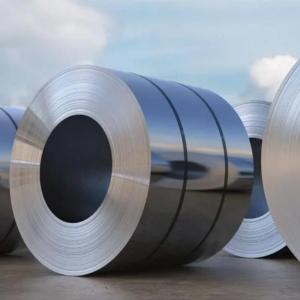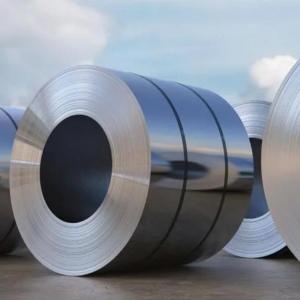Cold Rolle Steel Coil DC01 DC01EK DC04EK
- Loading Port:
- Shanghai
- Payment Terms:
- TT or LC
- Min Order Qty:
- 25 m.t.
- Supply Capability:
- 50000 m.t./month
OKorder Service Pledge
OKorder Financial Service
You Might Also Like
Details of Cold Rolle Steel Coil
The raw material of cold rolled steel coil is high quality hot rolled product, and after pickling, continuous rolling, degreasing, annealing, skin pass, slitting and cut to length line etc.
Along with it many kinds of new technology and new process of global cold rolling production have been applied. Therefore the quality of the goods could be guaranteed.
Standard: AISI,ASTM,BS,DIN,GB,JIS
Grade: DC01
Thickness:0 .8/1.0/1.2/1.5
Technique: Cold Rolled
Surface Treatment: Bright or black annealed
Width: 900mm-1500mm
Steel Grade: DC01, DC01EK, DC04EK
Tensile Strength: 270Mpa
Yield Strength: 270-410Mpa
AVAILABLE SPECIFICATION
| Thickness | 0.3-4.0mm (Full Hard Starting From 0.10mm) |
|---|---|
| Width | 30-2000mm |
| Sheets Length | 0-6000mm |
| Coil ID | 508mm or 610mm |
| Surface Treatment | Matt Finish/Bright Finish, Oil/Dry |
| Annealing Methods | Bright Anneal/ Black Anneal |
| Coil Weight | 5MT-25MT |
| APPLICATION | Steel Drum,Galvanized Steel, Steel Pipe, Home Appliance,Automobile etc. |
STANDARD & GRADE

Package & Shipment
| Package | Export standard packing(can do as required) |
| Container shipment | 20ft container/40ft container |
| Bulk shipment | if big order,then will save freight cost(while shipline may only one time one month) |
| Delivery | 20days(short as 7days,as many sizes in stock ) |
Picture of Cold Rolle Steel Coil

APPLICATION
Steel Drum, Galvanized Steel, Steel Pipe, Home Appliance, Automobile etc.
- Q:What are the different cutting methods for steel coils?
- There are several different cutting methods that can be used for steel coils, depending on the specific requirements and desired outcome. Some of the most common cutting methods for steel coils include: 1. Slitting: Slitting is a method that involves cutting the steel coil into narrower strips. This is typically done using a slitting machine that features multiple circular blades. The machine will unwind the coil and pass it through the blades, which will cut it into the desired width. Slitting is commonly used for applications that require narrower strips of steel, such as in the manufacturing of automotive parts or electrical appliances. 2. Shearing: Shearing is a cutting method that involves using a shear machine to cut through the steel coil. The machine will have a straight blade that is pressed against the coil, effectively cutting it into desired lengths or shapes. Shearing is often used for applications that require precise cuts or when the steel coil needs to be cut into specific sizes. 3. Laser cutting: Laser cutting is a more advanced cutting method that uses a high-powered laser to cut through the steel coil. The laser beam is directed onto the coil, melting or vaporizing the metal and creating a clean and accurate cut. Laser cutting is highly precise and can be used to cut intricate designs or patterns into the steel coil. It is often used in industries such as aerospace, automotive, and electronics. 4. Plasma cutting: Plasma cutting is a cutting method that uses a high-velocity jet of ionized gas to melt and remove the metal from the steel coil. The gas is usually a mixture of oxygen and an inert gas, such as nitrogen or argon. Plasma cutting is known for its speed and versatility, as it can cut through a variety of metals, including steel. It is often used in industries that require fast and efficient cutting, such as shipbuilding or construction. These are just a few of the different cutting methods that can be used for steel coils. The choice of method will depend on factors such as the desired outcome, the thickness of the steel coil, and the specific requirements of the application. It is important to consult with a professional or specialist to determine the most suitable cutting method for your specific needs.
- Q:How do steel coils contribute to the renewable energy sector?
- Steel coils contribute to the renewable energy sector in several ways. Firstly, steel coils are used in the manufacturing of wind turbines. The towers of wind turbines are made of steel, and steel coils are used to fabricate the structural components of these towers. The high strength and durability of steel coils make them ideal for withstanding the harsh environmental conditions in wind farms. Moreover, steel coils are also used in the production of solar panels. Steel is used to create the frames and support structures that hold the solar panels in place. These frames need to be strong enough to withstand wind and weather conditions, and steel coils provide the necessary strength and stability. Furthermore, steel coils are used in the construction of transmission lines that carry electricity generated from renewable sources. Steel is widely used for the poles and towers that support these transmission lines, as it provides the necessary strength to bear the weight of the cables and withstand extreme weather conditions. In addition, steel coils play a crucial role in the manufacturing of energy storage systems. Renewable energy sources such as wind and solar are intermittent, and energy storage systems help to store surplus energy for later use. Steel coils are used in the fabrication of battery enclosures and racks, ensuring the safety and stability of these systems. Overall, steel coils contribute significantly to the renewable energy sector by providing the necessary strength, durability, and stability for various infrastructure components. Their use in wind turbines, solar panels, transmission lines, and energy storage systems helps to support the growth and development of renewable energy sources, making them an integral part of the transition towards a greener and more sustainable future.
- Q:How are steel coils used in the production of automobile frames?
- Automobile frames rely heavily on steel coils, which are indispensable for their production. These coils, crafted from top-notch steel, undergo a process of uncoiling before being fed into a stamping press, where they assume various forms, constituting parts of the frame. The presence of steel coils is crucial as they furnish the frame with the requisite strength and rigidity, ensuring it can bear the vehicle's weight and maintain structural integrity. Once shaped, the coils are frequently welded together to construct the frame structure. This welding procedure securely binds the individual components, guaranteeing that the frame can endure the forces and strains encountered during the vehicle's operation. Utilizing steel coils in the production of automobile frames also allows for design flexibility, as they can be effortlessly shaped and manipulated to fulfill specific requirements. Moreover, steel coils possess exceptional durability and corrosion resistance, rendering them ideal for automotive applications. Frames fashioned from these coils are not only robust and dependable but also capable of withstanding harsh conditions and road vibrations. This not only enhances the vehicle's safety but also contributes to its longevity and overall performance. Steel coils also find use in other critical vehicle components, including suspension systems, chassis, and body panels. Their versatility, strength, and cost-effectiveness make them a favored choice in the automotive industry. Overall, the incorporation of steel coils in automobile frame production plays a significant role in guaranteeing the safety, durability, and performance of modern vehicles.
- Q:What are the different types of steel coil storage systems?
- There are several different types of steel coil storage systems, including coil racks, coil cradles, coil saddles, and coil bunks. Each of these systems is designed to safely and efficiently store steel coils in a warehouse or manufacturing facility. Coil racks are typically used for larger, heavier coils and have adjustable arms to accommodate different sizes. Coil cradles are used for smaller coils and provide a stable base for storage. Coil saddles are specifically designed to hold and transport coils with overhead crane systems. Coil bunks are used for storing large quantities of coils and provide a stacking system to maximize space utilization.
- Q:i need working shoes for women that have steel toe shoes? What store do they sell them in . i live in c.a.
- Do a search for local safety toe shoes. I have to have them for work also, and as a woman I can't just go to Walmarts. Unfortunately the store I go to is here in Atlanta, so not much help. But there are specialty stores for safety shoes. Brands I like are Hytest and Georgia Boots. Especially the Hytest instead of steel toes which are heavy the toes are kevlar.
- Q:How are steel coils used in the production of HVAC ducts?
- HVAC duct production relies heavily on steel coils, which are vital for their construction. These coils, typically composed of galvanized steel, possess the qualities of strength, durability, and corrosion resistance. To create the necessary flat sheets, the steel coils undergo an initial unwinding and flattening process. These sheets are then cut into specific sizes and shapes in accordance with the design and dimensions of the HVAC ducts. Additionally, the steel coils are subjected to various machines, such as shearing, slitting, and roll forming machines, to achieve the desired shapes and sizes for the ducts. Once transformed into the appropriate shapes, the steel coils are further processed to add additional features to the ducts. This can include bending, folding, or welding processes to create bends, angles, or connections in the ductwork. These processes allow for customization, ensuring that the ducts perfectly fit the specific requirements of the HVAC system and the building structure. Moreover, steel coils play a crucial role in maintaining the strength and integrity of HVAC ducts. The galvanized steel used in the coils provides a protective layer that prevents rust and corrosion, resulting in more durable and long-lasting ducts. This is particularly significant as HVAC ducts are regularly exposed to various environmental factors such as moisture, temperature changes, and airborne contaminants. In summary, steel coils are an essential and fundamental component in the production of HVAC ducts. They not only provide the necessary strength, durability, and corrosion resistance but also offer flexibility and customization in the manufacturing process.
- Q:I want a good quality, big, strong, steel knife but I want it to be a good price, say around $30 or less, $60 at the most. please add links.
- DAGS for combat knife
- Q:What are the different types of steel coatings for coil protection?
- There are several types of steel coatings for coil protection, including galvanized coatings, zinc coatings, aluminum coatings, and polymer coatings.
- Q:How are steel coils used in the manufacturing of agricultural silos?
- Steel coils are used in the manufacturing of agricultural silos as they are rolled into large cylindrical shapes to form the outer structure of the silo. These coils provide strength, durability, and resistance to external elements, ensuring the silo can withstand the weight of the stored agricultural products and protect them from moisture and pests.
- Q:I need to say how a bottle opener is made, would it be made from steel and can this be coloured? How?
- Steel can be plated(Chrome),Blackened(Black Oxide),Powder coated(color of your choose).All of this is done to prevent rust.All of these aforementioned processes can be worn off through being used.I suggest polished Stainless steel.
1. Manufacturer Overview |
|
|---|---|
| Location | |
| Year Established | |
| Annual Output Value | |
| Main Markets | |
| Company Certifications | |
2. Manufacturer Certificates |
|
|---|---|
| a) Certification Name | |
| Range | |
| Reference | |
| Validity Period | |
3. Manufacturer Capability |
|
|---|---|
| a)Trade Capacity | |
| Nearest Port | |
| Export Percentage | |
| No.of Employees in Trade Department | |
| Language Spoken: | |
| b)Factory Information | |
| Factory Size: | |
| No. of Production Lines | |
| Contract Manufacturing | |
| Product Price Range | |
Send your message to us
Cold Rolle Steel Coil DC01 DC01EK DC04EK
- Loading Port:
- Shanghai
- Payment Terms:
- TT or LC
- Min Order Qty:
- 25 m.t.
- Supply Capability:
- 50000 m.t./month
OKorder Service Pledge
OKorder Financial Service
Similar products
New products
Hot products
Related keywords





























